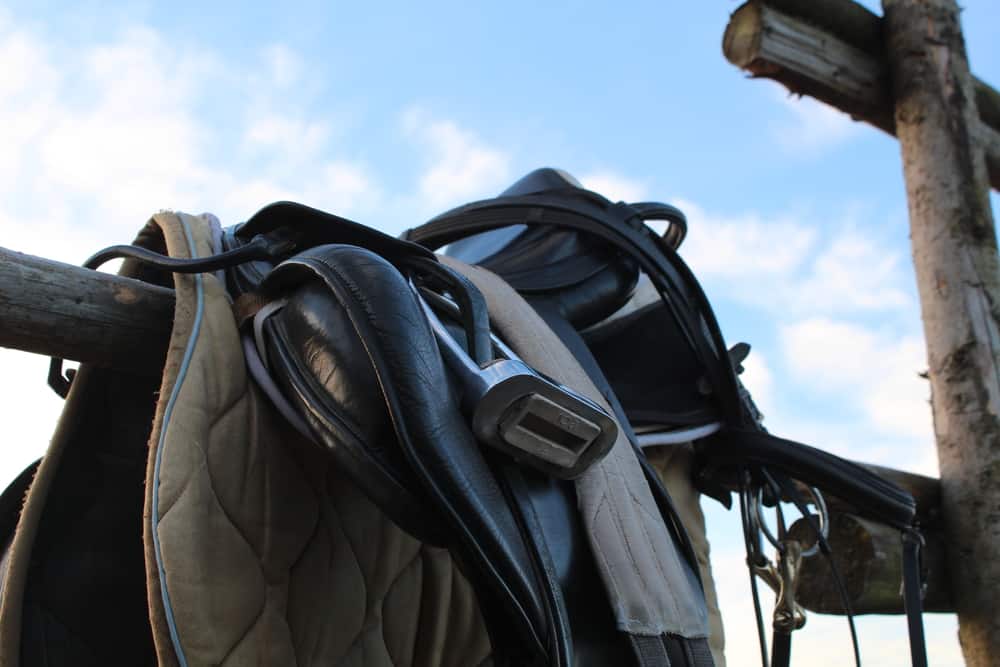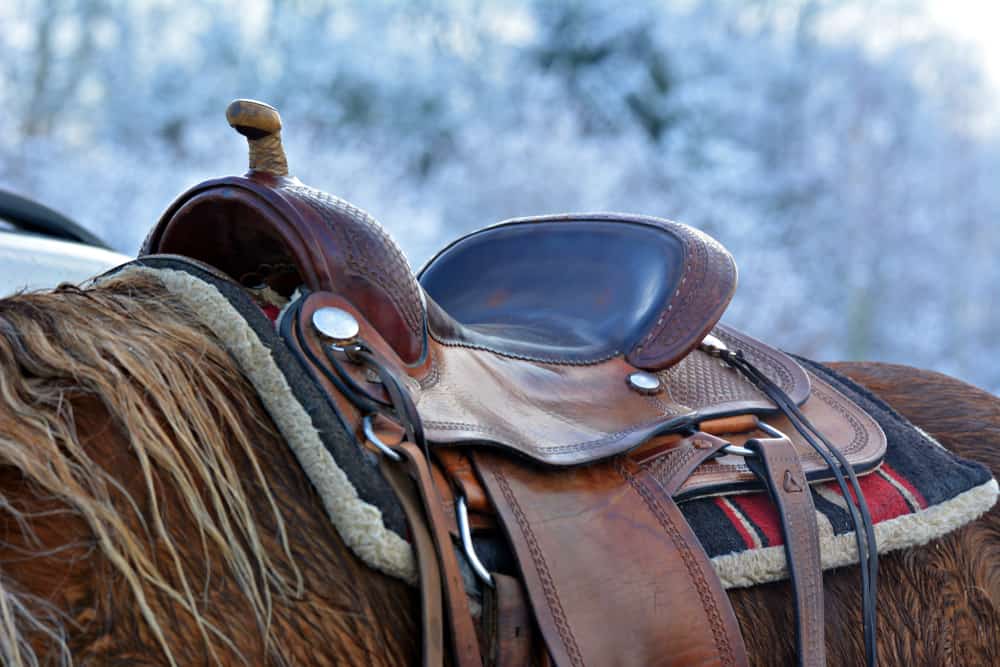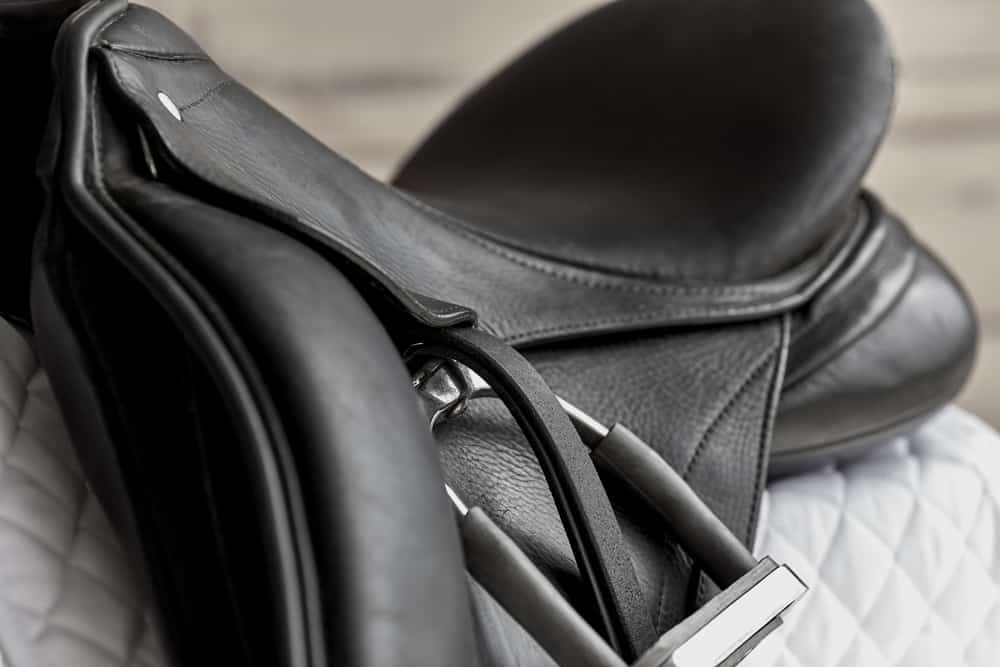- Your source for stall mats, rubber arena footing, arena harrows and arena dust control.

Let us talk about the difference between Western and English saddles—both types quite different in the equine world, used in vastly different disciplines. In my experience, having ridden in both of these types of saddles, it is hard to compare them when you are only looking at one type in each classification. So, which is better? Western saddles versus English saddles.
Western saddles are made from high-quality leather and used for riding in Western disciplines such as basic ranch, trail riding, show riding, etc. English saddles are made from leather or synthetic, lightweight material used in English disciplines like dressage, show riding, and show jumping.
There is always a big gap between Western and English riders in the equine world because the disciplines are so different. The style of riding and horsemanship varies greatly. Comparing these two types of saddles will give you a better idea of what kind of discipline you will be into and what type of saddle would suit you the best.
What Are Western Saddles Used For?
Western-style riding originates from riding in the plains of the old west. There are many different disciplines within Western that one can choose from. All the disciplines still have their origin from working ranch horses in the old west.
The riders’ attire also stems from these origins. For example, their chaps were used to protect the riders’ legs from chafing on the saddle and prevent their clothing from getting caught in brush and tumbleweeds.
Since the 1800’s the famous broad-brimmed hat has remained moderately unchanged. The American stock breeds – Quarter horses and Paints – remain the favorite breeds for Western Riding.
Western saddles are used for the following disciplines:
- Working ranch riding
- Trail and pleasure riding
- Roping
- Cutting
- Reining
- Barrel racing
- Endurance
- Show riding
- Horsemanship or Equitation
- Pole Bending
- Cow Horse/Pony
There are other subdivisions such as team and individual events and in-hand classes where the horses are shown in halters and do not use Western Saddles. We will discuss the differences between these saddles for each discipline later on.
What Are English Saddles Used For?
Horse riding has been around for many, many years. English saddles stem from European mounted Military and their riding style. Horseback riding goes back to 4500BC, and the culture of horseback riding has underwritten the way we ride our horses today. English riding is seen as a more traditional way of riding.
English riding is now used all over the world, whether for pleasure or recreation.
English saddles are used for the following disciplines:
- Dressage
- Show Jumping
- Eventing
- Hunting
- Show riding.
- Pleasure riding
- Trail riding
- Endurance
- Polo and Polo cross
- Saddle seat
- Side saddle
- Racing
- Pleasure riding
The Different Types of Western Saddles
In the earlier days, western riding was used to meet the needs of cowboys that worked on ranches and operated in the Old West. A Western saddle is designed to distribute the rider’s weight evenly over the horse’s back, and they are wider and heavier than English saddles.
The weight distribution of the saddle is designed to help the rider and the horse counterweigh a roped cow, for example. The seat is designed for comfort for long trail rides over different terrain.
Like the different disciplines within Western or English riding, there is a type of Western saddle for these disciplines. Each easily identified as a Western saddle, but they differ slightly to suit each discipline better.
Parts of a Western Saddle
The most important parts of a western saddle that will differ in design:
- Seat
- Cantle
- Swell
- Horn
- Fender
- Stirrups
- Rig
- Cinch
- Skirts
How to Fit a Western Saddle
- Gullet clearance
Let the horse stand square on an even surface and place the saddle on the horse without a pad. Between the horse’s whither and the saddle’s gullet, there needs to be a minimum space of two to three fingers width. The clearance must not be too much as this means that the gullet is too narrow; if it is low on the whither, the gullet is most likely too wide.
- Balance of the saddle
Look at the saddle while standing a bit further back from the horse. The seat needs to be level and parallel to the ground. For Western saddles: different rigging positions, shims, or moving the saddle a bit forward or back can be done to level the seat.
- Bars
The bars of the saddle needs to make even contact with the back. The bars may not cause excessive movement, rocking, or pressure onto the front or back of the horse’s back. This will prevent pressure points on the back.
The front of the bar of the tree should sit comfortably behind the shoulder blade of the horse. This will allow the horse to have free shoulder movement.
- Cinch tightness
The front cinch should not be over-tightened as it places pressure on the horse. A cinch should not be tightened to compensate for a bad saddle fit. The front cinch must be as tight as you would wear your belt.
The flank cinch only provides stability for the saddle, and the fit must be snug. A minimum of two fingers must be able to fit between the flank cinch and the apex of the horse’s belly. Connecting straps must be used to connect the front and flank cinch, and this will also place the flank cinch in the correct position.
Differences Between Western Saddles
| Type of Saddle | Seat | Cantle | Swell | Horn | Fender | Rigging |
| Ranch work | Deep, hard | High | Low | Tall and thick | Directly below the rider | Double |
| Trail riding | Medium, padded | Medium height | Varied | Thin | Directly below rider | Double |
| Roping | Deep, rough suede | Rounded, low | Low | Tall, thick and well-anchored | Hung more forward | Double |
| Cutting | Flat and long | Low | High and wide | Tall and thin | Forward hung, free-swinging | Double |
| Reining | Low and flat | Low | Medium height and slim | Medium height | Forward hung, narrow, free-swinging | Dropped, double |
| Barrel Racing | Deep and roughened | High | Wide | Thin and tall | Free swinging | Single, In-skirt |
| Endurance | Padded | Low | Low and wide | Hornless | Directly below rider | Centrefire |
| Show Riding | Padded and suede | Varied | Low | Short | Below rider, turned | Double, In-Skirt |
| Pleasure riding | See Trail Saddles |

The Different Types of English Saddles
English saddles, like western saddles, come in all shapes and sizes. Each discipline in the English riding world has some type of saddle that will fit the discipline. Compared to their Western counterparts, English saddles are smaller and lighter. These saddles are designed to stay out of the horse’s movement of their back and shoulders and provide a good seat that is secure for the rider.
Parts of an English Saddle
The different parts of an English saddle that will differ in design:
- Seat
- Cantle
- Pommel
- Stirrup holder
- Billets
- Knee rolls
- Panels
- Flaps
How to Fit an English Saddle (Without a Saddle Pad)
You can also watch the following video for a more detailed way to fit a saddle: https://www.besthorserider.com/what-size-english-saddle-do-i-need/
- Balance
Stand the horse square on a flat surface. Place the saddle on your horse, and the seat should appear flat. The saddle should not be tilting forward or backward.
- Wither clearance
This refers to the space between the horses whither and the pommel. This should be checked with and without the rider on. You should be able to fit in 2 to 3 fingers width between the pommel and the whither.
- Channel width
This part is often overlooked in saddle fitting checks. The spine, along with the large ligaments right next to the spine, must not be touched by the panels. The channel must be wide enough to clear the spine and ligaments, and the panels should not lie low on the ribs either.
- Billet alignment
The billets should either lie straight down. If the billets are crooked, this means that the balance of the saddle is off. The billets will determine where the girth goes; however, the girth must be a minimum of 5 inches behind the horse’s elbow.
- Length
The saddle should not extend further back than the last rib of the horse. This will mean that weight-bearing will be placed onto the lumbar vertebrae.
In addition to the points mentioned above, the saddle must allow freedom of shoulder movement and not be tight over the horse’s shoulders. All horses are not perfectly symmetrical. This means that one shoulder will naturally be bigger than the other.
The panels must be in contact with the back and must not have any gaps. This will allow for weight-bearing over a larger area. The tree should be checked for straightness and if it is still intact.
Differences Between English Saddles
| Discipline | Seat | Knee rolls | Flaps | Cantle | Pommel | Stirrup Bar | Billets |
| Dressage | Deep | Large and long | Long and straight | High | High | Directly under rider | Directly under rider. Long |
| Eventing | Deep | Medium, concealed | Padded, round | High | Lowered | Forward | Forward |
| Show riding | Medium | None | Long and straight | Flat | Back | Forward | Middle |
| Saddle seat | Long and flat | None | Flat, ends towards cantle | Flat | Cut back | Set forwards | Set back |
| Show jumping | Flat | Minimal | Rounded, forward | Flat | Cut back/flat | Forward | Forward |
| General purpose | Medium | Minimal | Rounded | Flat | Flat | Middle | Forward |
| Endurance | Broad and padded | Small | Flat and padded | High | High | Set forward | Forward |
| Side saddle | Flat and wide | None | Flat and long | Flat | Two | Single | Set back |
| Polo | Flat | None | Long and straight | Medium | High | Set forward | Set forward |
| Racing | Small, long, and flat | None | Far forward | Flat | Flat | Wooden bars | Forward |

How to Choose the Right Western Saddle?
Firstly, it is important to know which discipline you will be competing in or if it will only be for pleasure riding. This can point you in the right direction as to which saddle type to look at.
As for all saddles, it needs to fit your horse, and it needs to fit you. Seat sizes in western saddles can be smaller than 13 inches to as big as 17 inches long. To check if the sizing is correct for you, sit with your back placed against the back of the seat. The space between you and the fork should be at least 4 inches. When going from Western to English saddles, your seat size should go up approximately 2 inches.
When the saddle is placed on the horse, there should be a three-finger space between the horse’s whither and the gullet. The saddle should sit comfortably on the horse and not cause them any discomfort. The saddle should not interfere with the horses’ movement or move around on the back. The saddle must be comfortable for both horse and rider so that both can perform at their best.
How to Choose the Right English Saddle?
There are so many different types of English disciplines to choose from. If you are riding just for pleasure and occasionally hack out, a general-purpose or trail riding saddle would be best. They are cost-effective, comfortable, and easy to fit your horse.
However, if you choose to go into a more specific discipline and compete in it, a specified saddle like a dressage saddle or endurance saddle s what you need to look for. More specified saddles can become more costly, but some brands are cheaper than others for riders who do not need the top range.
English saddles need to be fitted to the horse correctly. This is because English saddles are designed to not interfere with the horse’s movement and can be used to enhance the horse and riders’ capabilities.
When contacting your local tack shop, you will need to inform them which discipline you are competing in, what breed of horse you have, and your budget. The tack shop should also have contacts with different saddle fitters that specialize in specific English saddle types. It can be hard to find the perfect saddle, but the saddle has to fit you and your horse well to be comfortable for both of you.
English saddle seats, excluding pony and children’s saddles, vary from 15 inches to 18 inches long. When sitting in the saddle, you should have 2 to 4 fingers width between your rear and the cantle and in the front between you and the pommel. The flaps of the saddle should also fit the rider. When the rider has their feet in the stirrups, their knees should sit comfortably at the knee roll and not go over the flap.
Conclusion
Western riding versus English riding is, as you can see, quite different from each other. Each riding technique stems from different countries with different needs at the time. One can choose to ride either Western, English, or both. However, you need to make sure to choose the correct saddle for each discipline.
Sources
https://www.usef.org/compete/disciplines/western
https://www.artbycrane.com/riding_styles_disciplines/western/index.html
https://www.thesprucepets.com/english-and-western-riding-differences-1886900
https://sportsaspire.com/history-of-horseback-riding
https://www.horse.com/content/western-tack/types-of-western-saddles/
https://horsyplanet.com/types-of-western-saddles/
https://healthyhorsehelp.com/blog/types-of-saddles-all-types-of-western-and-english-saddles/
https://www.besthorserider.com/what-size-english-saddle-do-i-need/

